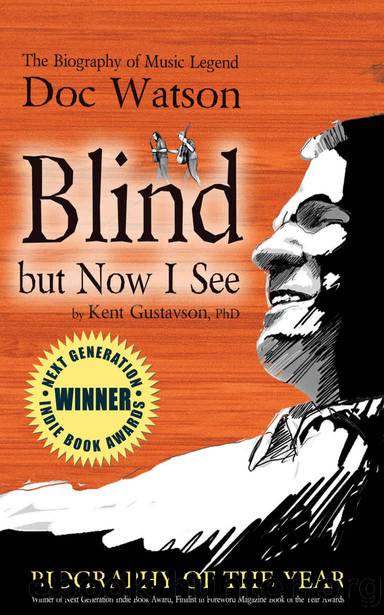Blind But Now I See: The Biography of Music Legend Doc Watson by Kent Gustavson

Author:Kent Gustavson [Gustavson, Kent]
Language: eng
Format: azw3
Publisher: Sumach-Red Books
Published: 2012-02-29T16:00:00+00:00
The meanings of Gerde’s Folk City within Doc Watson’s career were manifold. First, the two-week long engagement helped him first develop solo material in front of an audience that he would use for the rest of his career. Second, it allowed him to play with other folk musicians from within the New York City folk music scene. Third, it allowed him to promote his own name, and not be an accompanist as he had been for the last two decades. The last point was the most important. Doc had never been a headliner before. He had played some amazing gigs, but he had never been the headliner: certainly not in front of such a consistently packed and interested audience. During those two weeks in 1962, Doc forever endeared himself to the city that never sleeps.
One of the musicians who played with Doc for several nights during that first series of concerts at Gerde’s was John Herald, a member of the Greenbriar Boys with Ralph Rinzler. James Reams, a New York City old time musician and long time friend of John Herald, remembered, “Ralph Rinzler set it up for him to play with Doc. I think he was just flabbergasted at Doc’s abilities, and it was probably one of the biggest thrills in his life.”8 Herald also then recorded with Doc the next year on his first self-titled album with Vanguard.
Another influential musician who first played with Doc Watson on the stage of Gerde’s Folk City was David Grisman. For young Grisman, playing with Doc on stage was a major rite of passage. He remembered, “I was 17 at the time...and I think Ralph's younger cousin Richard put a bug in Doc's ear about me having a mandolin with me. In any case, Doc invited me up on stage to play a song or two. I remember playing ‘In the Pines’ and perhaps another tune. It made a profound impact on me because I had never been asked by a pro to sit in before that. It was then, and still is today, a great thrill to play with Doc.”9
That was the first time that Doc had the opportunity to share the stage with up-and-coming musicians, but certainly not the last. Playing with Doc on stage has been a rite of passage for generations. He played with the young flatpicking guitar wizard Clarence White on stage at Newport in 1963, brought Sam Bush, Marty Stuart and countless other instrumentalists along with their tours in the 1970s and 80s, played fiddle tunes backstage with blind fiddler Michael Cleveland in 1993, and shared a stage with young mandolinist Chris Thile at MerleFest in 2003. Playing with Doc on stage is a rite of passage, and the musicians of every decade who are lucky enough to join him on stage go on to become the innovators in their field.
Download
This site does not store any files on its server. We only index and link to content provided by other sites. Please contact the content providers to delete copyright contents if any and email us, we'll remove relevant links or contents immediately.
The Goal (Off-Campus #4) by Elle Kennedy(12433)
Kathy Andrews Collection by Kathy Andrews(10519)
Diary of a Player by Brad Paisley(6866)
What Does This Button Do? by Bruce Dickinson(5527)
Assassin’s Fate by Robin Hobb(5236)
Big Little Lies by Liane Moriarty(4880)
Pale Blue Dot by Carl Sagan(4001)
Sticky Fingers by Joe Hagan(3454)
The Heroin Diaries by Nikki Sixx(2931)
The Death of the Heart by Elizabeth Bowen(2901)
Beneath These Shadows by Meghan March(2718)
The Help by Kathryn Stockett(2704)
Confessions of a Video Vixen by Karrine Steffans(2674)
How Music Works by David Byrne(2525)
Jam by Jam (epub)(2489)
Harry Potter 4 - Harry Potter and The Goblet of Fire by J.K.Rowling(2416)
Strange Fascination: David Bowie: The Definitive Story by David Buckley(2367)
Petty: The Biography by Warren Zanes(2237)
Darker Than the Deepest Sea by Trevor Dann(2206)
